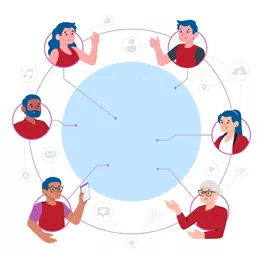
Introduction to Effective Communication
The more elaborate our means of communication, the less we communicate.
– Joseph Priestley
Introduction
Effective communication requires both sender and receiver to be focused on the act of communicating. While the sender must hone and enhance his or her speaking and writing abilities, the receiver must hone and improve their listening and reading abilities.
Communication skills were identified as the most significant criteria in choosing their employees by firms, according to a research. Oral and written communication abilities, as well as the capacity to interact effectively with coworkers, were shown to be crucial in predicting job performance.
When you think about it, this makes logic. If you can communicate well, you can effectively express your message to others, and they will have proper instructions to fulfill the given jobs. If you are unable to communicate effectively, your messages will be lost in translation. Communication failures create hurdles to your potential to grow professionally and personally, both.
Despite the fact that communication skills are critical for success in the job, many people find them to be a roadblock to their advancement. They struggle to accurately communicate their thoughts and ideas, making development not just difficult but sometimes practically impossible.
There is, however, hope for anybody who has difficulty communicating. These abilities may be honed and developed. It requires knowledge of how communication works, how to convey precisely what you want to say, the ideal style of communication, and the elements that influence your capacity to send and receive messages with aplomb.
In this lesson, we will look at the many facets of communication and strategies that you can employ in order to improve your communication skills.
Warm Up Exercise
With this warm up exercise, you are encouraged to consider the communication tactics that you are already using as well as areas in which you might make improvements. Consider a case in which you were denied an opportunity due to a lack of communication, and consider what communication skills in particular may have prevented the situation from occurring. Take some time right now to jot down your ideas on paper.

Working Definition of Communication
Communication is defined as the act of communicating information and meaning from one person or organization to another via the use of symbols that are mutually intelligible. The importance of meaning cannot be overstated. The transmission of meaning is the primary goal of all communication efforts. The process of communication is effective only when the recipient comprehends a concept in the manner in which the sender intended it. Both parties must be in agreement not only on the information that is communicated, but also on the meaning of the information that has been conveyed.
In order to effectively communicate a concept, we must employ symbols (words, signs, images, and sounds) that represent the notion in question. To communicate effectively, the symbols used must be understood by the person or individuals with whom we want to communicate. Both parties must attach the same meaning to the symbols that are employed; otherwise, there will be a misunderstanding.
Brief check
Communication is the transmission of information and meaning from one individual or group to another.

Forms of communication
The communication process may take one of three forms: 1. Spoken 2. Nonverbal 3. Written 4. Visual/Audiovisual. All these types of communication are often used in tandem in the vast majority of communications you send and receive.
According to researchers, we spend 50%-80% of our waking hours in communication. Of this: About 45% is spent in listening; About 30% is spent in speaking; About 15% is spent in reading; and About 10% is spent in writing.
Ways we communicate
Spoken: communication allows for a degree of formality or informality. Generally, spoken language is less formal so abbreviations and the omission of certain consonants occur, as in can’t, won’t, don’t, I’ll, and we’ll. Spoken communication is also provides prompt feedback. Very often the listener’s face provides feedback, and the speaker may alter the message on the go. Clarifications may be asked and provided simultaneously. Continuous exchange of ideas and points of view may bring the conversation to a satisfactory conclusion. There are two components to spoken communication: Verbal and Para verbal.
Verbal communication: which is what you say. Verbal communication is considered more natural and quick as compared to written communication. However, we also speak in formal and official contexts, such as while giving a presentation or conducting an interview in front of an audience that includes the target audience. Verbal communication can happen in many different ways such as –
- Direct communication: which includes the speaker and listener engaging directly, as in dyadic, small group, or public speaking situations.
- Telephone conversation: which involves two persons communicating through telephone, while teleconferencing may be used to connect a small group.
- The radio/podcast: which enables simultaneous communication with a big number of individuals.
Para verbal: This means how you say it – your tone, speed, pitch, and volume. It contributes to the effectiveness of what you say. When speaking, it helps to choose your words wisely, yet words alone are insufficient. Para verbal communication is critical in determining how your audience perceives you. It’s critical to keep this aspect of communication in mind while speaking to any audience, regardless of size. Not only what you say, but also how you say it has a significant impact on the effectiveness of your communication abilities. Para verbal communication enhances the significance of your words. You can take the same message and make it boring or exciting, depending on your delivery.
Non-Verbal: Nonverbal communication encompasses any forms of communication that are neither verbal nor written. Nonverbal communication has a significant effect and influence on how a message is decoded or interpreted by the recipient. These are the gestures and body language that accompany your words. Some examples: arms folded across your chest, tracing circles in the air, tapping your feet, or having a hunched-over posture. Nonverbal communication functions include –
- Reinforcement or complementing verbal signals, such as a warm greeting or a strong handshake.
- Refusal to accept the spoken message.
- Message replacement, i.e. nonverbal communication in the absence of verbal communication, such as pointing.
- Message accentuation/intensification i.e. smiling as you say, “It is nice to meet you.”
- Message regulation, which entails dropping the voice until the conclusion or eye contact in order to identify the next speaker.
Brief check
Because communication skills are learned, you control how well you communicate.
Written: When the other person is not accessible to speak on the phone or in person, written communication must be employed. Communication can also take place via fax, e-mail, or written word. Writing is the most effective method of communicating long and complicated information. Features Written Communication include:
- Speed: Written communication takes longer to prepare, transport, and receive. It also takes longer to create, type, send, receive and read a letter for example than it does to talk. Written communication likewise has a slower response time than spoken communication.
- Documentation: Written communication acts as a record and may be used as a reference for future reference. As a documented proof, it has the potential to be utilized in a court of law. Written records and papers are more dependable and accepted than oral records and documents.
- Formality, accuracy and precision: Written communication is more formal and accurate. In written communication, accurate word choice is feasible since the writer has the time to search for appropriate words and phrases, as well as to change the manuscript if required. In written communication, accuracy is essential since the recipient will not be there to ask for clarification if anything is incorrect.
- Length: A written message is often shorter in length than a spoken one. In the case of oral communication, certain prior and concluding statements are required, although for written communications, standard templates for opening and closing are available, which allow the message to be kept as brief as possible.
- Expense: It is necessary to spend money on stationery, preparation, and transmission in order to communicate effectively by written means.
- Response: When communicating via writing, feedback is delayed; the writer is unable to observe the reader’s facial expressions, and the writer is only aware of the reader’s answer when the reader responds. The reader may respond in a careful and guarded manner, without allowing the other person to show his or her genuine emotion.

Visual and audiovisual tools for communication
Visual encompasses images, posters, graphs, infographics, charts, and billboards, among other things. Organizations make considerable use of visual aids such as blueprints, progress charts, maps, scale models of items, and similar gadgets. The use of such means of communication is increasing in training and education as well as in organisational communication. As the saying “a picture is worth a thousand words” implies, photographs may convey strong visual imagery. Indeed, many businesses have created advertising copy that is entirely composed of images; but, images should be coupled with well selected words and actions to convey the whole message.
Audiovisual communication on the other hand includes the use of broadcast films in cinemas, slides shown on a projector screen, a computer, a television, and video. It is the most up-to-date mode of communication. It is a synthesis of vision and sound. Audiovisual communication is well suited to public relations, mass propaganda, and mass education. Large corporations commonly use this strategy to educate their employees and promote their goods. Audiovisuals can successfully show how a new product works. Audiovisual communication is best suited for widespread publicity and education campaigns.
Other Factors in Communication
Other communication factors that we need to consider.
Method: The method in which the communicator shares his or her message is important as it has an effect on the message itself. Communication methods include person-to-person, telephone, e-mail, fax, radio, public presentation, television broadcast, and many more!
Mass: The number of people receiving the message.
Audience: The person or people receiving the message affect the message, too. Their understanding of the topic and the way in which they receive the message can affect how it is interpreted and understood.
ESSENTIALS OF EFFECTIVE COMMUNICATION
Effective communication requires both sender and receiver to be focused on the act of communicating. While the sender must hone and enhance his or her speaking and writing abilities, the receiver must hone and improve their listening and reading abilities. The communication traits that the sender must possess are referred to as the C’s of Communication, since the majority of them begin with the letter C.

1. Correctness
A letter must be accurate in all of the following areas:
(i) In spelling, grammar, pronunciation, and language usage: Inappropriate language detracts from the message, diverts the receiver’s attention, and gives a negative image of the presenter; it may also transmit an incorrect message. All spellings must be verified; particular attention must be paid to the spelling of names. The majority of individuals feel upset when their name is misspelled or mispronounced. The usage of numbers, units of measurement, technical words, abbreviations, hyphens, grammar, spelling, punctuation, and capitalization must all be consistent. American and English spellings are not identical. There are no strict standards for hyphenation, punctuation, or capitalizations, so whichever option you choose, maintain consistency across the document.
(ii)In terms of look and arrangement: A messy look, with typographical errors repaired in ink, irregular spacing, or carelessness in the layout, conveys an unfavorable picture of the person who is communicating and effectiveness in managing his/her job. The appearance of the letterhead is contingent upon the precise placement of components on the letterhead, consistent spacing between letters, words, lines, layout components, and suitable margins on both sides. Similarly, a speaker’s unkempt look and lack of attention to body language gives a negative impression.
(iii) That the information given is accurate and complete: The most detrimental aspect of communicating incorrect or partial information is that it wastes time making adjustments and results in a loss of goodwill and business. All dates and days of the week, as well as time, numbers, and facts, must be consistent. Nothing is more perplexing than contradictory information.
(iv) The tone, formality, and style must be suitable for the occasion, the topic, and the sender-recipient connection: An excessive apology sounds childish or unworthy; a reluctant or patronizing consent to accommodate a request comes out as unappealing.
2. Clarity
The message must be obvious at first reading in order for it to be easily followed and understood. Messages that are clearly written or spoken reduce misunderstandings and save time. Write and communicate with the intention of expressing, not of impressing. Clarity is dependent on five factors:
(i) Simple, commonplace language that is easily understood by everyone: Never direct the reader’s attention to the dictionary. Avoid using technical words unless absolutely necessary and when communicating within your profession.
(ii) Concise and straightforward sentences: Long sentences perplex the reader, and often the writer as well. Phrases or clauses should be added to a sentence. Each significant piece of information should be presented in a separate sentence.
(iii) The use of appropriate punctuation and pauses: It aids in the provision of pauses and stops and to break up large groupings of words into manageable chunks. Apart from the full stop, there are other, shorter pauses such as the semicolon and comma that aid in the division of a phrase into legible pieces.
3. Consistency
The usage of numbers, units of measurement, technical words, acronyms, language, spelling, punctuation, capitalization, and dates should all be consistent. British and American spellings are not identical. The requirements for hyphenation, punctuation, and capitalization are not rigid. The important point is to maintain consistency across the document based on whichever option you choose.
4. Coherence
Coherence is the logical progression of thoughts. Establishing a clear framework is necessary while communicating, whether its through presentation or a letter for example. Being coherent ensures that the ideas are presented in a logical sequence or logical linking of ideas, which makes any communication, spoken or written easier to grasp. Consistency in numbering also contributes to the achievement of coherence.
5. Concreteness
Using numbers and names to provide specific and clear facts. Vague expressions such as “in due course” or “at your earliest convenience” are less effective than specific time frames such as in two weeks or within three weeks, soon, good, or at any time. Utilize precise and distinct terms and expressions to convey information. It is preferable to utilize specific terms with a clear definition or to provide explicit examples and descriptions. The terms “good,” “bad,” “far,” and “near” make meaning only when you specify the degree of efficiency or quality and the rate of change.
6. Conciseness
Conciseness entails communicating a great deal in a few words; in business communication, this meansusing the fewest relevant words without losing clarity or courtesy. This does not always mean writing in short; it means making each word count. Conciseness may be accomplished by –
(i) Omitting superfluous modifiers, such as “new innovation” (is there such a thing as an old innovation?) or “very one-of-a-kind” (unique means only “one of its kind”). Additionally, “advance planning,” “real experience,” “cylindrical in form,” and “three cubic meters in volume” are instances.
(i) Condensing insignificant concepts into phrases or single words, such as –“in the form of” to “as”, “in many cases” to “often”, “exhibits the ability” to “ can”, “in the event of” to “ if”.
(iii) Ensuring that only required and relevant information is provided. Using more words than required creates confusion about the concept.
Conciseness and clarity are inextricably linked; providing precise and specific facts often lowers the length of a statement. Readers like succinct and straightforward messaging. Irrelevant thoughts and going out of point confuses the listener.
7. Courtesy
Courtesy is an expression of regard for the sentiments of others. It is manifested via an individual’s interactions with others. A person who is well mannered and polite demonstrates attention and concern for others. In a letter, the writer’s tone, demeanor, and choice of words indicate his or her civility. Several basic rules of civility include the following:
(i) When appropriate, employ the courtesy terms such as please, thank you, excuse me, and sorry.
(ii) Demonstrate appropriate emotion in response to the event. For instance, pity when someone is in pain, best wishes when someone embarks on a new endeavor, and congratulations when someone accomplishes something.
(iii) Create a sense of comfort for the other person. This is a critical aspect of civility. The following is an example from a letter that demonstrates concern and regard for the reader. The introductory statement itself demonstrates the writer’s courtesy:
- We appreciate your promptness in delivering the items;
- We appreciate your promptness in giving your quote.
- We’re sorry for the inconvenience.
Additionally, requests must be expressed courteously:
- We would be really grateful if you could submit your payment within three days of receiving our invoice.
- Will you kindly check into this immediately?
(iv) Be alert and timely in your responses. Each communication, whether written or spoken, should be responded to within twenty-four hours. If the letter is a complaint, the response should be prompt; a polite corporation will quickly call or send a fax message upon receiving a complaint or learning of a problem. Everybody values fast attention.
(v) Allow the tone, word choice, and style of the message to show your regard for the receiver’s emotions and needs. This is especially critical if the message being given is likely to be offensive to the reader. A respectful letter will most likely get a favorable answer. Seeing the issue through the reader’s eyes and attending to his or her requirements is an act of respect. You must be careful about how the words sound to the recipient.
Brief check
Developing good communication skills requires instruction, practice and feedback.
8. Completeness
The communication should be complete with all relevant elements and information to facilitate the receiver’s comprehension and reaction.
Practical Application
Michael and Jane work for a large company selling premium cookware. They were putting the last touches on a presentation for a crucial business meeting the next day. They were supposed to present the range of products to potential distributors in their state. Michael was preparing to give a presentation, but he was unsure of his ability to communicate well since he lacked confidence in presenting. Jane on the other hand was not so confident to prepare an effective presentation but was very optimistic about presenting. They both decided to help each other and focus on what they do best.
Jane and Michael focused on the three modes of communication – verbal, nonverbal, and written to create and rehearse the presentation. They employed as many effective communication tactics as they could to help each other do their part as best as they could.
The two of them worked as a group and at the end of the day, it gave them the confidence that their they had employed all communication strategies they knew to not just written presentation but also to the delivery – including the non-verbal signals they would use, the vocal abilities they will apply, the pace for their presentation etc. Michael was glad to see that he had prepared for the occasion, and Jane was pleased to discover that her advice might be of assistance in a professional setting. This case is also a good example of how organizations big or small depend on smooth communication among staff to operate effectively.





